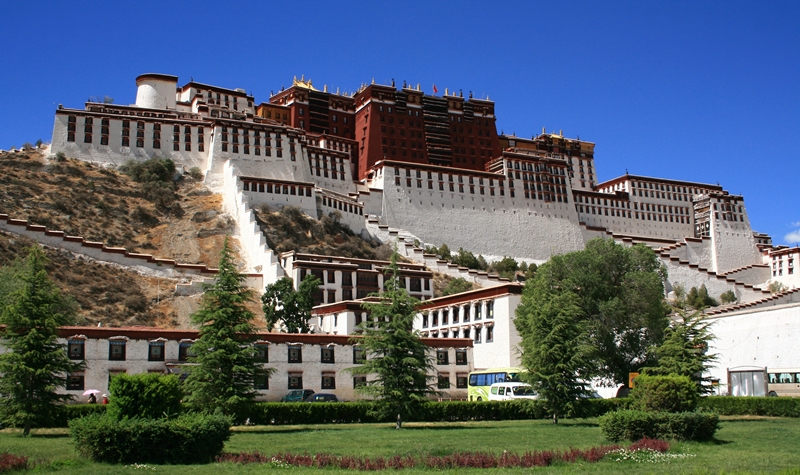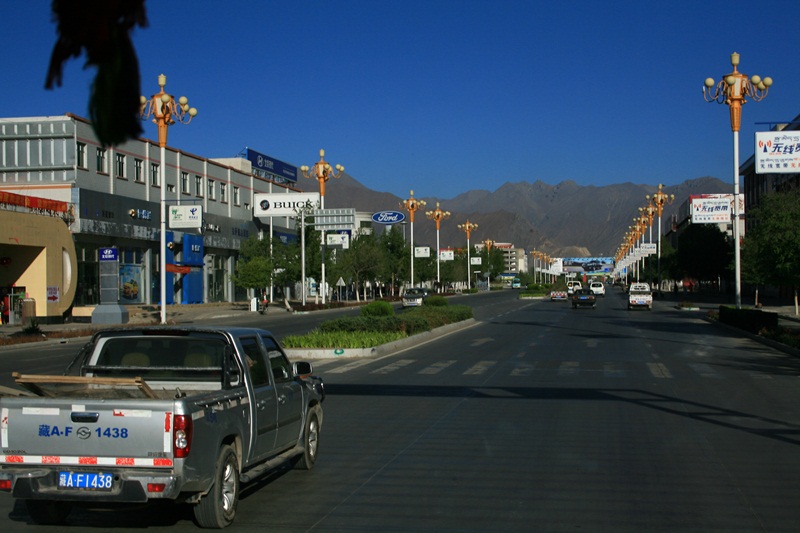


The Potala Palace
 The Potala Palace in Lhasa, Tibet Autonomous Region, China, was the chief residence of the Dalai Lama until the 14th Dalai Lama fled to India during the 1959 Tibetan uprising. It is now a museum and UNESCO World Heritage Site.
The Potala Palace in Lhasa, Tibet Autonomous Region, China, was the chief residence of the Dalai Lama until the 14th Dalai Lama fled to India during the 1959 Tibetan uprising. It is now a museum and UNESCO World Heritage Site.
 The palace is named after Mount Potalaka, the mythical abode of Chenresig or Avalokitesvara. Lozang Gyatso, the Great Fifth Dalai Lama, started its construction in 1645 after one of his spiritual advisers, Konchog Chophel (died 1646), pointed out that the site was ideal as a seat of government, situated as it is between Drepung and Sera monasteries and the old city of Lhasa.
The palace is named after Mount Potalaka, the mythical abode of Chenresig or Avalokitesvara. Lozang Gyatso, the Great Fifth Dalai Lama, started its construction in 1645 after one of his spiritual advisers, Konchog Chophel (died 1646), pointed out that the site was ideal as a seat of government, situated as it is between Drepung and Sera monasteries and the old city of Lhasa.
 It may overlay the remains of an earlier fortress, called the White or Red Palace, on the site built by Songtsen Gampo in 637
It may overlay the remains of an earlier fortress, called the White or Red Palace, on the site built by Songtsen Gampo in 637
 The building measures 400 metres east-west and 350 metres north-south, with sloping stone walls averaging 3 m. thick, and 5 m. (more than 16 ft) thick at the base, and with copper poured into the foundations to help proof it against earthquakes.
The building measures 400 metres east-west and 350 metres north-south, with sloping stone walls averaging 3 m. thick, and 5 m. (more than 16 ft) thick at the base, and with copper poured into the foundations to help proof it against earthquakes.
 Thirteen stories of buildings – containing over 1,000 rooms, 10,000 shrines and about 200,000 statues – soar 117 metres (384 ft) on top of Marpo Ri, the “Red Hill”, rising more than 300 m (about 1,000 ft) in total above the valley floor
Thirteen stories of buildings – containing over 1,000 rooms, 10,000 shrines and about 200,000 statues – soar 117 metres (384 ft) on top of Marpo Ri, the “Red Hill”, rising more than 300 m (about 1,000 ft) in total above the valley floor
 Tradition has it that the three main hills of Lhasa represent the “Three Protectors of Tibet.” Chokpori, just to the south of the Potala, is the soul-mountain (bla-ri) of Vajrapani, Pongwari that of Manjushri, and Marpori, the hill on which the Potala stands, represents Chenresig or Avalokiteshvara
Tradition has it that the three main hills of Lhasa represent the “Three Protectors of Tibet.” Chokpori, just to the south of the Potala, is the soul-mountain (bla-ri) of Vajrapani, Pongwari that of Manjushri, and Marpori, the hill on which the Potala stands, represents Chenresig or Avalokiteshvara

SERA MONASTERY
 Séra Monastery is one of the ‘great three’ Gelukpa university monasteries of Tibet, located 1.25 miles (2.01 km) north of Lhasa. The other two are Ganden Monastery and Drepung Monastery. The origin of the name ‘Séra’ is attributed to a fact that the site where the monastery was built was surrounded by wild roses (se ra in Tibetan language) in bloom.
Séra Monastery is one of the ‘great three’ Gelukpa university monasteries of Tibet, located 1.25 miles (2.01 km) north of Lhasa. The other two are Ganden Monastery and Drepung Monastery. The origin of the name ‘Séra’ is attributed to a fact that the site where the monastery was built was surrounded by wild roses (se ra in Tibetan language) in bloom.
 The original Séra monastery is located in Lhasa, Tibet, about 5 kilometres (3.1 mi) north of the Jokang and is responsible for some 19 hermitages, including four nunneries, which are all located in the foot hills north of Lhasa. The Sera Monastery, as a complex of structures with the Great Assembly Hall and three colleges, was founded in 1419 by Jamchen Chojey of Sakya Yeshe of Zel Gungtang (1355–1435), a disciple of Tsongkhapa
The original Séra monastery is located in Lhasa, Tibet, about 5 kilometres (3.1 mi) north of the Jokang and is responsible for some 19 hermitages, including four nunneries, which are all located in the foot hills north of Lhasa. The Sera Monastery, as a complex of structures with the Great Assembly Hall and three colleges, was founded in 1419 by Jamchen Chojey of Sakya Yeshe of Zel Gungtang (1355–1435), a disciple of Tsongkhapa
 During the 1959 revolt in Lhasa, Séra monastery suffered severe damage, with its colleges destroyed and hundreds of monks killed. After the Dalai Lama took asylum in India, many of the monks of the Sera Monastery who survived the attack moved to Bylakuppe in Mysore, India.
During the 1959 revolt in Lhasa, Séra monastery suffered severe damage, with its colleges destroyed and hundreds of monks killed. After the Dalai Lama took asylum in India, many of the monks of the Sera Monastery who survived the attack moved to Bylakuppe in Mysore, India.
 After initial tribulations, they established a parallel Sera Monastery with Sera Me and Sera Je colleges and a Great Assembly Hall on similar lines to the original monastery, with help from the Government of India. There are now 3,000 or more monks living in Sera, India and this community has also spread its missionary activities to several countries by establishing Dharma centres, propagating knowledge of Buddhism.
After initial tribulations, they established a parallel Sera Monastery with Sera Me and Sera Je colleges and a Great Assembly Hall on similar lines to the original monastery, with help from the Government of India. There are now 3,000 or more monks living in Sera, India and this community has also spread its missionary activities to several countries by establishing Dharma centres, propagating knowledge of Buddhism.
 The Séra Monastery in Tibet and its counterpart in Mysore, India are noted for their “Monk Debates” on the teachings of Buddha and the philosophy of Buddhism. Sera Monastery developed over the centuries as a renowned place of scholarly learning, training hundreds of scholars, many of whom have attained fame in the Buddhist nations.
The Séra Monastery in Tibet and its counterpart in Mysore, India are noted for their “Monk Debates” on the teachings of Buddha and the philosophy of Buddhism. Sera Monastery developed over the centuries as a renowned place of scholarly learning, training hundreds of scholars, many of whom have attained fame in the Buddhist nations.
CITYSCAPE
Lhasa Prefecture covers an area of close to 30,000 km2 (12,000 sq mi). It has a central area of 544 km2 (210 sq mi) and a total population of 500,000; 250,000 of its people live in the urban area
 Lhasa is home to the Tibetan, Han, and Hui peoples, as well as several other ethnic groups, but overall the Tibetan ethnic group makes up a majority of the total population
Lhasa is home to the Tibetan, Han, and Hui peoples, as well as several other ethnic groups, but overall the Tibetan ethnic group makes up a majority of the total population



text taken from wikipedia


Fantastic photographs.. 🙂 Very interesting article.
thank u 🙂